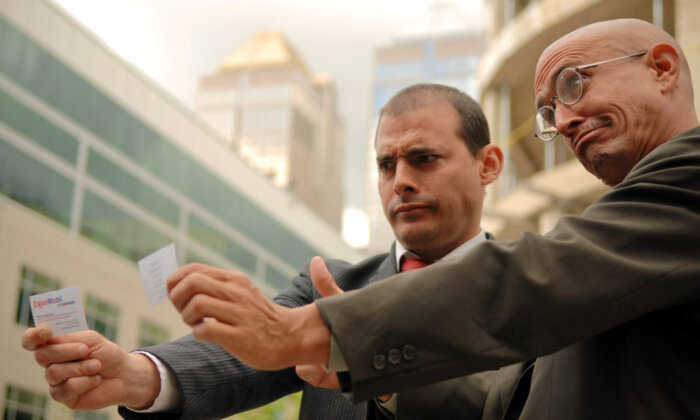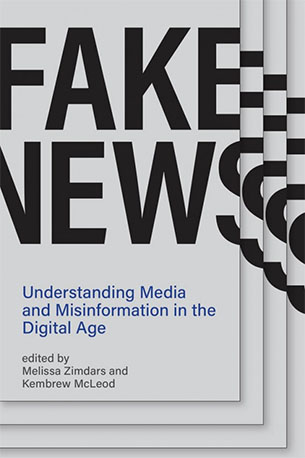Pranksters on a Mission: An Interview With the Yes Men

For more than two decades, the Yes Men have demonstrated the many ways pranking and similar deceptions can shake people out of their daily routines and rewire taken-for-granted realities. By turning the world upside down — even for a brief moment — it can be seen from a new vantage point, a different perspective. This can spur people to imagine a better society and, occasionally, turn fantasy into reality through the hard work of community building and activism.
I was introduced to Igor Vamos and Jacques Servin, a.k.a. Mike Bonanno and Andy Bichlbaum, a.k.a. the Yes Men, through my friend Sarah Price, who in 2003 co-directed the first feature-length documentary film about the duo. As a like-minded mischief-maker, I bonded with them and we later ended up collaborating on a project that critiqued recent trends in higher education and what was then happening at the University of Iowa (UI), where I teach. On August 26, 2015, the Yes Men used their “identity correction” tactic during a satirical press conference we staged in Iowa City, where they impersonated two representatives from the firm Pappas Consulting. This firm had been hired by the Iowa Board of Regents to conduct a series of “efficiency reviews” for the purpose of cutting costs, and jobs. Using the pseudonyms Bert Schwingler and Morton Oorst — names they made up on the spot while we were rehearsing — the Yes Men announced several modest proposals: allowing the campus community to hold direct elections for the Iowa Board of Regents, opening up tenure-track lines to all adjuncts, and redistributing upper-admin salaries to create living wages for all university workers.

The Yes Men also announced that UI would adopt an open-border asylum policy for all Wisconsin university employees negatively affected by the actions of Wisconsin governor and Republican presidential candidate Scott Walker, who made headlines in 2015 by effectively eliminating tenure at state universities and slashing state university budgets. The Yes Men’s fake press conference resulted in a visit by UI’s Threat Assessment Team, though life on campus continued imitating the Yes Men’s performance art. Eight days later, the Iowa Board of Regents unanimously voted former IBM and Boston Market executive Bruce Harreld as UI’s next president — despite submitting an error-ridden résumé, having no university administrative experience, and giving a disastrous public job talk where he cited Wikipedia, among other things. It was later revealed that his presidency was engineered by the regents, who actively recruited him by holding highly questionable private meetings that skirted open records laws.
To summarize: The Yes Men posed as fake representatives of a consulting firm and the Threat Assessment Team was called in, while at the same time other forms of chicanery resulted in Harreld being installed as the president of UI. I developed a better understanding of how the Yes Men operate after working with them on the faux press conference, sitting in during the planning stages of another one of their actions, and having several informal conversations with them over the years. The Q&A that follows, which took place in 2019, examines the tactics they have used in the past, while also reflecting on the ways the media landscape has shifted since 2016.
Kembrew: When was the first time you realized that you could engineer situations so that news media would disseminate your ideas?
Andy: We had been playing around with fake websites and setting up websites for various entities we didn’t like — Shell was the first one — and it was just kind of playing with the technology. It was 1998 or 1999, and the internet was pretty new. We never intended these things to actually fool anyone. It was more just like, “We want to fool people briefly.” Sort of like satire, but it was really important that people believe it was the actual site, and then they read a little closer and they realize what it’s actually saying. It wasn’t really like we were trying to fake out the news that much. We intended to get people to think, and then we ended up accidentally giving the news something to play with so that they would cover those important issues.
“I just accidentally created a media firestorm around something really, really stupid. Maybe there’s a way that this can actually be meaningful in a bigger way?”
Mike: This was right around the time when Yes Men was beginning, but Andy’s SimCopter hack seemed to me like a big a-ha moment — like, “I can just make up anything I want now, you know?”
Andy: I e-mailed a journalist acquaintance an account of what happened, and he just said, “Oh my God, that’s such a great story.” An AP [Associated Press] reporter wrote about it, and it was all over, and on TV news, and so on and so forth. At the point when that started to die down, I sort of thought, “Well, there is something there that’s very interesting. I just accidentally created a media firestorm around something really, really stupid. Maybe there’s a way that this can actually be meaningful in a bigger way?”
Kembrew: Mike, what was the first eye-opening moment for you, when you realized a lone individual with a weird idea could engineer widespread media coverage?
Mike: I think it was sort of two steps, and one of the things that makes sense to mention is that I had read that RE/Search Pranks! book. You know the book. That had a chapter on Alan Abel, a chapter on Joey Skaggs that I remember really, really well. Those things sort of leapt out at me as being really interesting. … So then a little bit later, I started the Barbie Liberation Organization project. With that, I was really just going for it in a much more focused way based on having read about what Alan Abel and Joey Skaggs did. And then I just started to figure out how PR works, trying to do it myself. You don’t realize how far you can take it until you’re really in it. I had sort of a gradual introduction to it.
Andy: Mike said he learned a bit how it works as he was doing it and figured things out while going along, and I kind of did too. I mean, basically I had figured how press releases worked, so I sent these messages out to reporters. I had a little list of them, especially the ones who had covered the SimCopter hack.
Kembrew: Can you just talk about how the media landscape and the technology has shifted over the two decades that you’ve been doing this, and what that has meant for the kinds of actions that you currently do?
Andy: When I did the SimCopter hack, I sent out e-mail press releases to people I knew, like, “Hey Lee, I know you work for the L.A. Times, what do you think of this?” Then it just took off; I started getting the e-mails from other journalists. There was no physical mailing of things, except we did package an ®TMark video press release as beta tapes, and dropped them off across the country in TV stations’ mailboxes for journalists, because we were crossing the country anyhow. We had a very elaborate plan that totally didn’t work at all. There was absolutely no effect. What did work was the online thing, the website, but we couldn’t have known that. Talk about learning as you go. Websites were new. There weren’t a lot of corporate sabotage websites, and you could publish it on the web and journalists would find it. Even if they kind of only half believed it, they would write about it.
Mike: There were lots of stories. I think there was one year where we had about four or five prominent stories in the New York Times about individual projects from ®TMark, which was crazy.
Andy: Keep in mind this was the 1990s, when the dot-com bubble was in full swing, and you had companies that delivered dog food raising enormous capital. There was all this nonsense that burst in 2000, but this was the time that people thought the web could do anything, and that was extremely important.
Kembrew: One last thing about the late-1990s. Can you talk briefly about the G. W. Bush campaign website, because that seemed like another significant turning point in the evolution of the Yes Men.
Mike: The critical difference with what we do is we’re telling stories to reveal more information, not to obscure it. With the G. W. Bush website, the idea was to always reveal our real position in an interview with the press, as we do with all of the stuff we’ve done. There is a phase in which you reveal it, and then we get more attention and get to tell the whole story — you get to get the facts and information in that you want to. What we’re doing is not really “fake news,” although it uses trickery to get there. It fits in better with traditions of satire, where the goal of the satire is not to make people believe something that is false, but rather to get them interested in discovering the truth. Jonathan Swift didn’t write “A Modest Proposal” so that more people would think that the Irish should eat their own babies. He wrote it to provoke a reaction and, through that reaction, reveal that the English were starving the Irish.
Jonathan Swift didn’t write “A Modest Proposal” so that more people would think that the Irish should eat their own babies.
Andy: That example, by the way, is a really good way to get in to how things have changed since 2016. Talking about how the Irish should eat babies was sort of predicated on nobody thinking it was a good idea to eat babies. We’re just assuming nobody in our audience really likes the idea of eating babies. That’s kind of the premise of what we were doing with all of our fake websites and fake press releases. It was pushing the organizations that we were mocking to a really extreme version of their positions — like with the WTO [World Trade Organization], or G. W. Bush, or whatever it was. But I think now we’re in a very different moment. Jonathan Swift depended on a belief in universal values that human life is important and that humans shouldn’t be eaten, and they also shouldn’t be enslaved. You couldn’t say, “I want to enslave people” or “I want to imprison immigrants in concentration camps.” You couldn’t say those things, but now we’re in a very different moment where fundamental, universal values are in question and not being respected. So [we’re] pushing our targets to say an extreme example of what they think doesn’t work anymore. It’s not guaranteed that it will offend people, and you can’t rely on universals like human rights.
Kembrew: With that in mind, what space is there left for the kind of things that you two have been doing for a quarter century?
Andy: Like everyone, we’re having to reexamine what we’re doing — it was like putting a Band-Aid on a severed head. In retrospect, it’s clear if you’re in a world where there seems to be an arc of improvement, a lot of things that used to make sense now no longer make sense. In labor history, unions in the 1970s really took a turn away from proper organizing — where you try to reach out to workers on the factory floor who don’t necessarily agree with you at the beginning, but you need them. That’s extremely powerful, and that model really is responsible for all the gains of labor, starting in the 1930s. In the 1970s, unions took up a mobilizing model, which is what social movement organizations often do, like Greenpeace, Move On, et cetera, et cetera. All of them basically mobilize people who already agree with them to do things and get media attention and hopefully somehow pressure leaders. That works in smaller ways, but not nearly as well as actual organizing. Where we are now is, we have to look back at the drawing board. It’s not a matter of doing the same things anymore.
Kembrew: We’ve talked about the term fake news, but for clarity’s sake, how do you define fake news, and how do the Yes Men’s tactics fit into this concept?
Mike: I guess I would say there are two versions of fake news: one is news that is intended to deceive, but the other is news that is simply untrue and it is spread without the intention of deceiving anybody. The other fake news can just be populist bullshit that people want to repeat, but it’s simply untrue. I mean, Trump creates fake news all the time just by tweeting crazy shit. There has to be a distinction between what we do, which is to tell a few lies in order to reveal a bigger truth, and what this other fake news is doing.
Kembrew: Because you have both taught in the college classroom, what do you do to try and instill better critical thinking skills when it comes to media consumption?
Mike: I think that by teaching through examples of manipulating media — by talking about, by showing, or by showing [students] a documentary, for example, about how the PR industry basically helped start the Gulf War in 1991. Those kinds of things call into question their entire reality, because they go, “Oh, holy shit, this entire reality is being created. It’s not just happening; there are people who are making it happen in a particular way and they’re presenting selective facts to me.”
I think the real question is, “How do you actually blow the minds of people who don’t agree with you?”
Andy: I’ve used those examples too, like the PR industry is the biggest purveyor of fake news in history, with a budget of billions of dollars a year, things like that. But I think the real question is, “How do you actually blow the minds of people who don’t agree with you?” We’re no longer in a place where everybody kind of agrees on the same definition of reality at all, or the same definition of what is unacceptable or acceptable. I don’t think that would [have been] the case 10 years ago, so there’s a different kind of work that has to be done now that has to do with communicating that there is a different reality besides the reality of hatred and fear and building walls and all that.
Mike: My feeling right now is that I don’t really know what works anymore. It used to be that we were very, very successful with traditional journalism, where we could reach other journalists who would recognize this as a fun story and would write about it. With there being so many fewer journalists, and also having to find something that’s sticky in social media, it almost necessarily requires it to be vastly simplified. We used to tell really complex stories, because journalists can distill a very complicated story and make it really great, but now it’s like, “How do you get these hooks on social media?” It is kind of distasteful, because to do it, you’re kind of catering to like the lowest common denominator. But that’s one of the reasons that fake news works so well, because you can actually tell really simplistic, dumb, aggravating, annoying stories really easily and really quickly — really incendiary things that you target for a very specific audience that you know will spread it. I find it hard to understand how to do this stuff usefully and consistently; it’s harder for me than it was, and I feel like an old codger saying this.
Andy: Yeah, yeah, me too. It’s definitely harder. Yes, the technology makes it a little harder, but not impossible at all. The technology is sort of the least of the problems, but it does make it a little harder. I think it would still be possible to get on the BBC as a spokesperson for Dow Chemical, for example, because back then they could have googled just as easily as they can now. What is missing, I think, is the purpose and the effectiveness of what are essentially corporate campaigns. I think everything we’ve done is effectively a corporate campaign — maybe a more radical and interesting and funny version of it than you usually see, but not necessarily more effective, just different. I think something like the Dow thing we did was effective, and it generated media for it and helped to mobilize people and so on and so forth. It was fully ensconced in the realm of corporate campaigning, which I think is really a model that has proven its inability to really keep us safe. Once you lose sight of the question “Why are we doing this?” it becomes hard to do these things. It’s not a technical problem, it’s a “Why are we doing this?” problem. It did make perfect sense before 2016 — or it seemed to, and I think it did, given what we knew — but now it has all blown up.
Kembrew McLeod is an American artist, activist, and professor of Communication Studies at the University of Iowa. He is co-editor of “Fake News,” from which this interview is excerpted, and the author of several books, including “Pranksters: Making Mischief in the Modern World” and “Freedom of Expression:
Resistance and Repression in the Age of Intellectual Property.”



